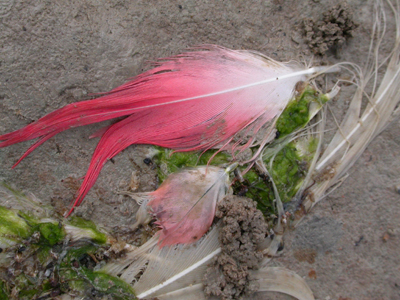Environmental trace element composition can have an important impact on ecosystem and population health as well as individual fitness. Therefore, carefully assessing bioaccumulation of trace elements is central to studies investigating the ecological impact of pollution. Colonial birds are important bioindicators since non-invasive sampling can easily be achieved through sampling of chick feathers, which controls for some confounding factors of variability (age and environmental heterogeneity). However, an additional confounding factor, external contamination (ExCo), which remains even after washing feathers, has frequently been overlooked. A new method was developed to reliably interpret bioaccumulation of 10 trace elements (As, Cd, Cr, Cu, Hg, Ni, Pb, Se, Sn and Zn) in feathers using chicks of a colonial species: the Greater Flamingo, Phoenicopterus roseus. First, only shafts were used to remove ExCo retained in vanes. Secondly, we applied a thorough washing procedure. Thirdly, we applied a new analytical method to control for ExCo, which assumes that ExCo is mainly due to adhered sediment particles and that the relative concentration of each trace element will be similar to the sediment geochemical composition of sampling sites. This new methodology was validated by comparing trace element composition and particle composition of washed and unwashed feathers. ExCo was successfully controlled by calculating the ratio of ExCo due to sediment using the geochemical fingerprint of sediment samples. This methodology leads to conservative estimates of bioaccumulation for As, Cd, Cr, Cu, Hg, Ni, Pb, Se, Sn and Zn. Overlooking ExCo leads to potentially erroneous conclusions. informacion[at]ebd.csic.es: Borghesi et al (2015) Assessing environmental pollution in birds: a new methodological approach for interpreting bioaccumulation of trace elements in feather shafts using geochemical sediment data. Met Ecol Evol Doi: 10.1111/2041-210X.12644
http://onlinelibrary.wiley.com/doi/10.1111/2041-210X.12644/abstract


 Las altas temperaturas están provocando que las lagunas y las marismas de Doñana pierdan agua rápidamente
Las altas temperaturas están provocando que las lagunas y las marismas de Doñana pierdan agua rápidamente




